|
|
Acrobatic Nocturnal Lights
Are We Looking in the Wrong
Direction?
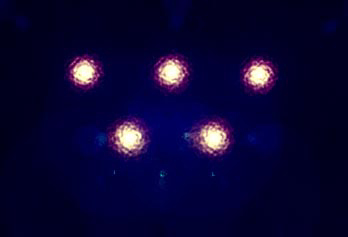
April 2004 by Daniel V. Boudillion
|
Introduction
In the course of investigating
the odd and unusual in New England, I have ended up (of necessity)
reading a considerable number of books on
Unidentified Flying Objects. In the course of my reading I have made
several observations – all quite obvious – that have not (to my
knowledge) been addressed in the literature. Here is one such for
your consideration.
Note: My writing this
article does not imply that I am a believer in UFOs or UFO entities. My
position on all such subjects is a cautious skepticism. Whether these
objects are real is not the subject of this essay, rather these are
observations made on events as described in the literature as I
understand it.
Acrobatic Nocturnal Lights
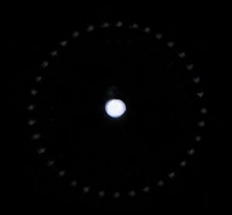 This observation has to do with
a certain type of sighting of nocturnal lights in the sky. There is a
particular scenario that comes up repeatedly in UFO literature: a person
sees what appears to be a star moving around in the sky forming
geometric patterns. Usually this episode begins with a sighting of a
"star" that seems to be blinking and/or wandering around the night sky.
When the observer notices it and focuses on it, this seems to attract
the attention of the moving light. It is at the point that the observer
becomes aware of the light that the light seems to suddenly become aware
of the observer. This is often indicated by the light suddenly rushing
briefly right at the observer, and then returning to the sky, where it
begins a series of maneuver that form geometric shapes and patterns.
[See
In the Big Thicket by Rob Riggs, for example.] This observation has to do with
a certain type of sighting of nocturnal lights in the sky. There is a
particular scenario that comes up repeatedly in UFO literature: a person
sees what appears to be a star moving around in the sky forming
geometric patterns. Usually this episode begins with a sighting of a
"star" that seems to be blinking and/or wandering around the night sky.
When the observer notices it and focuses on it, this seems to attract
the attention of the moving light. It is at the point that the observer
becomes aware of the light that the light seems to suddenly become aware
of the observer. This is often indicated by the light suddenly rushing
briefly right at the observer, and then returning to the sky, where it
begins a series of maneuver that form geometric shapes and patterns.
[See
In the Big Thicket by Rob Riggs, for example.]
On occasion this attention is
said to be gained by the observer blinking a flashlight at it, only to
find the light blinks back in the same patterns. In any event, once the
attention has been gained, the light typically goes from a wandering
mode to a performance mode.

A typical performance mode
example includes a light tracing what appears to a large square in the
sky, as seen from the observers position. Other geometric shapes have
been seen to be traced in the night sky as well by these types of
lights.
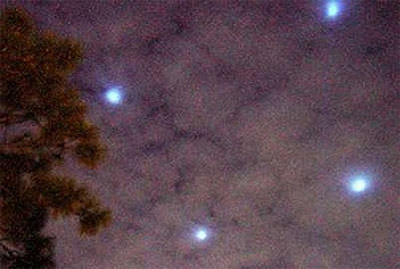
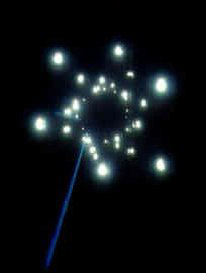
Anomalous Aerial Lights Forming
Patterns
Often, the star-like light will
separate into several lights of the same size and intensity, and perform
synchronized acrobatic maneuvers. The lights may maneuver to mark the
corners of squares, triangles, rectangles, and make patterns etc. –
flowing silently from one geometric form or pattern to another with
precision and timing.
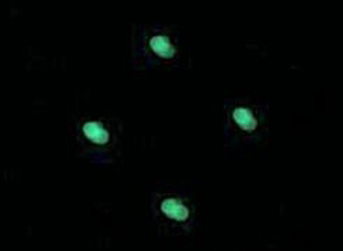
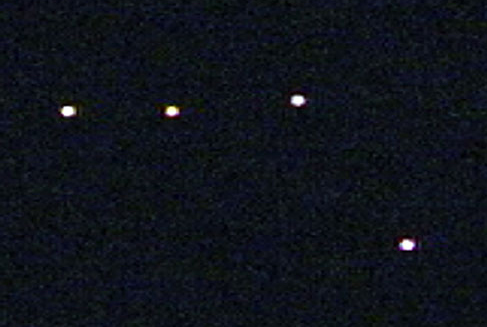
Anomalous Aerial Lights Forming
Patterns
The lights move from position to
position with rapidity, traversing large swathes of the night sky in
split seconds, and apparently, at extraordinary speeds. They also are
seen to execute right-angled turns, again at what would calculate out to
be extraordinary speeds and remarkable g-forces.
Another similar scenario is when
a glowing light – not mistakable for a star – performs the same routine
at much lower elevations: splitting up into several glowing lights,
forming geometric shapes between them, or morphing itself from orb shape
to triangular to more complex shapes. The lower level glowing light
scenario may also include synchronized color changes.
Assessment
What I initially observe in
these accounts is that the geometric shapes and patterns created by the
maneuvers are only recognizable as such from the viewing point of the
observer. From a different observational position, these maneuvers
would not result in the appearance of perfect geometric shapes being
traced in the night sky – they would
presumably still be seen, but not acting with geometric coherence.
Also, that these maneuvers result in what appear to be exact
geometric shapes, means that they can only be viewed as exact from the
exact position of the observer.
Let’s put ourselves for a moment
in the position of the "star"-lights in the sky. For the sake of
illustration, let us say that each maneuverable light is piloted, and
that you are one of these pilots. First, thousands of feet down there
in the dark is a person you are putting on the performance for. Somehow
you know that they are thinking of you, and you respond with a precision
air show.
To make your maneuvers result in
geometric shapes – whether you are working alone or with other pilots –
requires bearing in mind that your geometric figures are made not from
your perspective, but from the viewers perspective. What you do in the
sky is only meaningful, geometrically, to how it is seen from an exact
view-position thousands of feet below on the ground. It is easy to
stand in front of a blackboard and draw a square with chalk, but it is
quite another thing to be the chalk (if chalk were able to move of its
own volition) and maneuver singularly or with other chalks to create
drawings on the blackboard in such a way that they present exact
geometric shapes to a specific view-perspective somewhere across the
room.
And, consider that the
blackboard drawings are drawn on a flat surface, but that the sky-shapes
are made in a three dimensional space. Nevertheless, the sky-shapes
have all the precision of drawings done on a blackboard positioned to be
viewed from an exact location.
Challenges
The sky presentation scenario
phenomena seems to have a number of challenges. These being:
• It becomes aware that a person
is mentally focused on it.
• This "awareness" happens at
night in the dark from what appears to be miles away.
• It separates into other
lights.
• The light or lights maneuver
to make the appearance of geometric shapes and patterns in the sky.
These can only be seen as such from an exact view-position: the
observers position.
• Reports do not come in of
people observing these maneuvers from an off-position location. Only
exact head-on positions. No one ever seems to be witnessing someone
else’s show.
• The lights appear to make
"impossible" right angle turns.
• The lights appear to move at
"impossible" speeds.
Are We Looking In The Wrong Direction?
Assuming that these events
appear as reported, I admit I do not know what the reality of the
situation is. However, it does strike me that a literal different
perspective might shed insight into the event. Perhaps we are looking
in the wrong direction.
Let’s go back to the blackboard
illustration. Let us say a person (the observer) was sitting in a
classroom facing the blackboard. Let us say the lights were off and the
shades pulled. Let us say a person (the presenter) entered the room
unbeknownst to the observer and stands at the desk behind them. Then
let us say the presenter takes out one of those laser pointers used for
making presentations. The presenter doodles the light point across the
blackboard until he has the observer’s attention. When he has his
attention, he then proceeded to draw squares and triangles on the
blackboard. If the observer gets up and moves over one seat, so does
the presenter, thus keeping the shapes presented exactly dead-on to the
observer. The light point makes right-angled turns on the blackboard,
and, if the observer were under the impression that the blackboard was
the canvas of the night sky, this would give the appearance of it moving
at impossible speeds over large distances, and making impossible turns.
Let’s say the presenter now takes out a small machine that holds 4 laser
pointers. This machine moves the pointers so their light points move in
concert and make squares and other geometric shapes and patterns on the
blackboard surface.
Another excellent illustration
of a sky-shapes presentation system would be a planetarium.
Conclusion
I do not know what the actual
reality of these sky presentations are, but it would seem much easier to
project them from behind the observer than to coordinate it and present
it from the vantage point of the light in the sky facing the observer.
The laser pointer in the illustration is a metaphor, not a fact, but as
such it gets the mind looking in another direction. Perhaps a person
being presented with such a display would do well to look behind
themselves, at least metaphorically.
Email Daniel V.
Boudillion
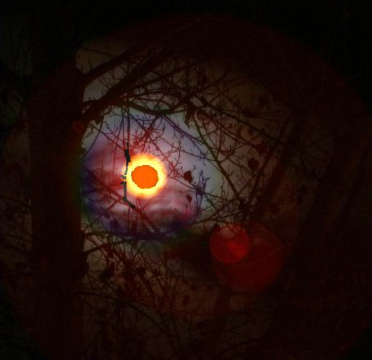
Back to Field
Journal
Copyright © April 2004 by Daniel V. Boudillion
|